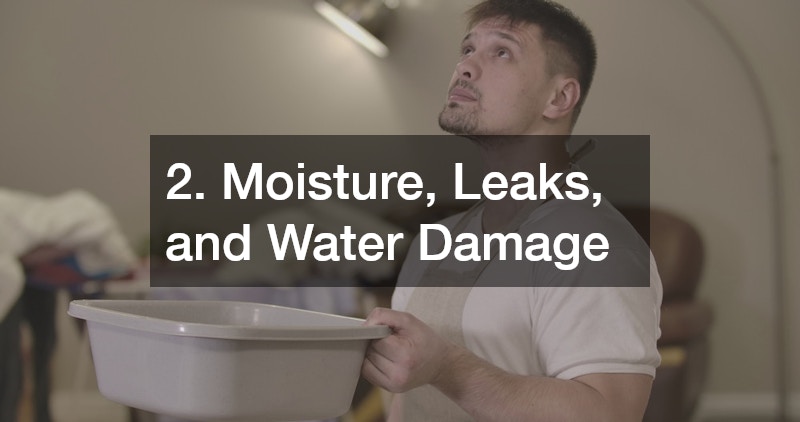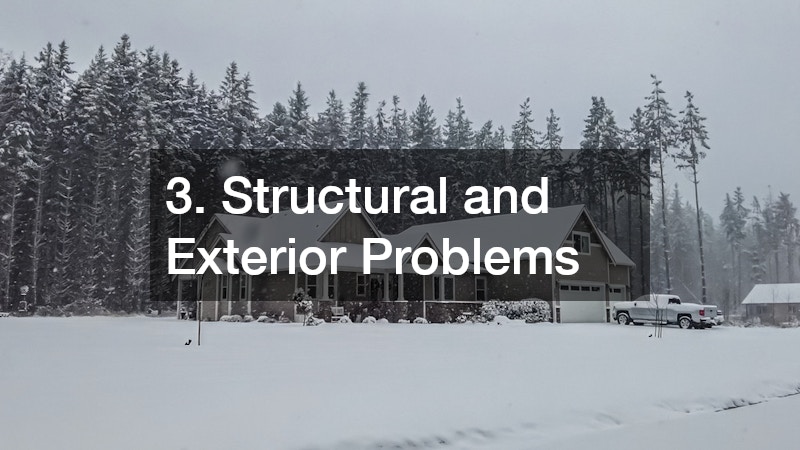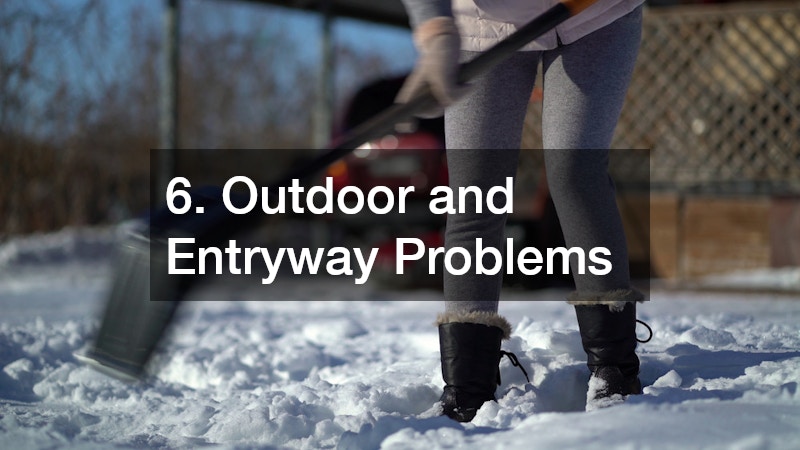Winter can be tough on your home. Between dropping temperatures, snow, ice, and high winds, your house can face a lot of stress that might not show up until it’s too late. From heating issues to frozen pipes, moisture problems, and even safety hazards, winter introduces a unique set of challenges for homeowners. In this guide, we’ll walk through the most common winter house problems and how you can stay ahead of them.
1. Heating and Energy Efficiency Issues
Furnace Not Heating or Blowing Cold Air
There’s nothing worse than waking up on a freezing morning only to find your furnace isn’t working. A furnace that blows cold air can have several causes. Sometimes it’s as simple as a dirty filter or a tripped switch. Other times, it might be a more serious issue, like a malfunctioning pilot light or a problem with the gas supply.
When your furnace starts acting up, the first step is to check the basics: ensure the thermostat is set correctly, the circuit breaker hasn’t tripped, and the filter is clean. If everything seems fine but the air is still cold, it’s time to call in a professional for a deeper inspection. Regular maintenance can prevent most furnace problems before winter hits.
Uneven Room Temperatures
Ever notice that some rooms in your house are always toasty while others feel like iceboxes? Uneven heating is often caused by poor insulation, blocked vents, or improperly balanced ductwork. Furniture and curtains can also interfere with heat circulation, leaving certain areas cooler than others.
To fix this, start by adjusting vents and dampers to improve airflow. Adding insulation to your attic, basement, or walls can make a big difference. For more extensive insulation needs, hiring a spray foam insulation contractor ensures your home is sealed properly and retains heat efficiently, helping every room stay comfortable throughout the winter.
Drafts Around Windows and Doors
Drafty windows and doors are a common winter annoyance. Even small gaps can let cold air in and warm air escape, making your heating system work harder and driving up energy bills.
Sealing drafts is usually straightforward. Weatherstripping, caulking, and door sweeps can all help. Heavy curtains or thermal window coverings provide an extra layer of insulation, keeping cold air at bay and reducing the chill in your home.
High Heating Bills
Winter can be expensive. Between short days, long nights, and a furnace working overtime, it’s easy for heating bills to skyrocket. Common culprits include poor insulation, leaky windows, and old, inefficient heating systems.
You can lower costs by sealing gaps, adding insulation, and upgrading to a programmable thermostat. Simple habits like lowering the thermostat when you’re not home and keeping doors closed in unused rooms can also make a noticeable difference. For more comprehensive solutions, scheduling professional HVAC services can help ensure your system is running efficiently, identify hidden energy drains, and keep your home comfortable without overspending.
Heat Pump or Boiler Malfunctions
Heat pumps and boilers are reliable systems, but winter puts extra strain on them. A heat pump may ice over or lose efficiency, while a boiler can experience pressure drops or leaks, leaving your home uncomfortably cold.
Preventative maintenance is key. Schedule a professional inspection before the coldest months arrive, and pay attention to any unusual noises or fluctuating temperatures. If your home relies on oil for heating, regular heating oil services can help keep your boiler or furnace running smoothly, making your system more efficient and reducing the risk of unexpected breakdowns. Catching small problems early can save you from a major heating crisis when you need it most.
2. Moisture, Leaks, and Water Damage

Ice Dams on the Roof
Ice dams form when heat escaping through your attic melts snow on the roof, which then refreezes at the edges. This blockage prevents proper drainage and can cause water to seep under shingles, damaging ceilings, walls, and insulation.
Preventing ice dams starts with proper attic insulation and ventilation. Installing roof rakes or heating cables can help manage snow and ice buildup. Ignoring the problem can lead to costly repairs, so it’s better to tackle it early.
Frozen Pipes
Frozen pipes are a classic winter headache. Water inside pipes expands as it freezes, which can cause them to burst and flood your home. Pipes in unheated areas like basements, attics, and garages are particularly vulnerable, and a single burst can lead to costly water damage.
Preventative measures include insulating exposed pipes, keeping a slow trickle of water running during extreme cold, and maintaining a consistent indoor temperature. If a pipe does freeze, it’s important to thaw it carefully to avoid bursts. For more extensive plumbing needs or recurring issues, calling professional plumbing services can ensure your pipes are properly insulated, repaired, and maintained before winter hits.
Basement Flooding During Thaws
Spring-like thaws in the middle of winter can cause unexpected basement flooding. Snow melting rapidly can overwhelm drainage systems, especially if gutters or downspouts are blocked.
To reduce risk, keep gutters clear, ensure proper grading around your home, and consider installing a sump pump if your basement is prone to flooding. Regular checks during heavy snow or ice melt periods can prevent major water damage.
Window Condensation
Condensation occurs when warm indoor air meets cold window surfaces. While a little moisture is normal, excessive condensation can lead to mold growth and rotting window frames.
Use dehumidifiers to control indoor humidity, open curtains or blinds for better airflow, and consider insulating windows. Storm windows or thermal window film can also help reduce moisture buildup and keep rooms warmer.
Leaky Roofs After Heavy Snowfall
Snow and ice can damage shingles or find weak spots in your roof. Leaks may appear slowly or suddenly during a thaw, causing water damage to ceilings and walls.
Regular inspections before winter, snow removal when necessary, and timely repairs at the first sign of damage are key. Even a small leak can lead to mold growth or structural problems if left unattended.
3. Structural and Exterior Problems

Roof Damage from Heavy Snow Loads
Snow accumulation adds significant weight to roofs, particularly flat or older structures. Over time, this can lead to sagging, leaks, or even partial collapse, putting your home and family at risk.
Removing excess snow safely with a roof rake and reinforcing older roofs can prevent damage. It’s also a good idea to tackle roof repairs if you notice any signs of stress, such as sagging areas, damaged shingles, or unusual noises. Addressing these issues early helps maintain the structural integrity of your home and avoids costly emergency fixes later.
Cracked Foundations
The freeze-thaw cycle can cause your foundation to shift and crack. Water entering small cracks can freeze, expand, and worsen the problem, potentially leading to uneven floors, sticking doors, or more serious structural issues.
Prevent foundation damage by maintaining proper drainage, keeping gutters clear, and monitoring for cracks. If you notice significant or recurring cracks, prioritizing foundation repairs can help stabilize your home and prevent costly long-term damage. Early intervention is always easier and more affordable than waiting for a major problem to develop.
Warped or Cracked Siding
Extreme temperature swings can warp vinyl siding or crack wood panels. Moisture infiltration can worsen the issue, leading to rot or mold.
Inspect siding before and during winter, seal gaps, and repair damaged sections promptly. Regular maintenance keeps your home weather-tight and preserves its appearance.
Gutter Damage from Ice Buildup
Ice can weigh down gutters, pulling them away from the house and damaging downspouts. Blocked gutters increase the risk of water entering your home.
Clean gutters before winter, use gutter guards, and remove ice carefully when necessary. Avoid climbing on ladders in dangerous conditions — professional help is safer.
Driveway and Sidewalk Cracks
Freeze-thaw cycles can damage concrete and asphalt, creating cracks and uneven surfaces. Slippery conditions can make walkways hazardous for your family and guests.
Regular maintenance like sealing cracks, shoveling snow, and using safe ice-melt products helps, but for extensive or persistent damage, a skilled paving contractor can repair and resurface your driveways and sidewalks, ensuring safety and durability throughout the winter.
4. Electrical, Fire, and Safety Concerns
Overloaded Circuits from Space Heaters
Space heaters are great for keeping small areas warm, but they can easily overload circuits, trip breakers, or even cause fires if not used carefully.
To prevent issues, make sure electrical loads are distributed evenly, plug heaters directly into outlets instead of extension cords, and never leave them unattended. If you regularly rely on multiple high-power devices, consulting professional electrical services can help upgrade your wiring or circuits to handle the extra demand safely.
Carbon Monoxide Buildup
Faulty furnaces, gas appliances, or blocked vents can produce carbon monoxide (CO), a colorless, odorless gas that’s deadly in high concentrations.
Install CO detectors on each floor, maintain appliances annually, and ensure proper ventilation. Recognize symptoms like headaches or dizziness as warning signs of CO exposure.
Fire Hazards from Heating Devices
Heaters, fireplaces, and wood stoves are potential fire hazards if misused. Flammable materials too close to heat sources can ignite quickly.
Keep heaters away from curtains, furniture, and paper, and never leave open flames unattended. Regular cleaning of fireplaces and chimneys reduces fire risk.
Power Outages During Snowstorms
Snowstorms and ice can knock out power lines, leaving you without heat, lights, or appliances.
Keep backup power options, flashlights, and extra batteries handy. Unplug sensitive electronics during storms to prevent damage from power surges.
Malfunctioning Smoke or CO Detectors
Cold temperatures and low humidity can affect smoke and CO detectors. Dead batteries or dust buildup may prevent them from functioning.
Test detectors monthly, replace batteries twice a year, and clean units regularly to ensure they’re reliable when you need them most.
5. Indoor Air Quality and Comfort Problems

Dry Indoor Air
Winter air tends to be dry, especially in heated homes. Dry air can cause static electricity, dry skin, respiratory irritation, and damage to wooden furniture.
Use humidifiers, houseplants, or even bowls of water near heating sources to add moisture. Maintaining indoor humidity between 30–50% keeps everyone comfortable.
Stale or Stuffy Air
Sealed windows and doors keep warmth in but can trap pollutants, odors, and allergens inside. Stuffy air can be uncomfortable and unhealthy over time.
Open windows occasionally, use exhaust fans, and change HVAC filters regularly to keep air fresh and circulating properly.
Mold Growth in Hidden Areas
Hidden corners of your home, such as basements, bathrooms, or attics, are especially prone to mold when moisture from leaks or condensation accumulates. Mold not only damages surfaces but can also create health problems, including allergies and respiratory issues.
To prevent mold from spreading, keep these areas well-ventilated, fix any leaks promptly, and use dehumidifiers to control excess moisture. If mold becomes persistent or widespread, turn to professional mold removal companies for a thorough cleanup, protecting both your home and your family’s health.
Window Frost and Fogging
Frosted or foggy windows not only reduce visibility but also let cold air seep into your home. Condensation between panes often signals a broken seal, which can lead to higher energy bills and uncomfortable indoor temperatures.
To combat this, consider upgrading your windows with storm panels, thermal film, or better insulation. Installing replacement windows can solve persistent issues, improve energy efficiency, and keep your home warmer and more comfortable throughout the winter months.
Allergies from Dust and Dry Air
Heating systems circulate dust and allergens, aggravating seasonal allergies. Dry air can worsen symptoms like itchy eyes, sinus irritation, and coughing.
Clean vents, replace filters, and use a humidifier to balance air quality and comfort throughout the winter.
6. Outdoor and Entryway Problems

Frozen Locks and Doors
Moisture can freeze inside locks, preventing doors from opening. Cold can also make wooden doors shrink or crack.
Keep locks lubricated with graphite powder, use weatherproof covers, and clear snow and ice from entryways regularly to prevent problems.
Cracked Outdoor Pipes and Faucets
Exposed water lines and garden faucets are susceptible to freezing and cracking. A burst pipe can cause costly water damage.
Disconnect hoses, drain outdoor lines, and insulate pipes before temperatures drop. This simple prep saves major headaches later.
Slippery Driveways and Walkways
Ice and packed snow create slip hazards for residents and visitors. A simple fall can cause serious injury.
Shovel snow promptly, apply sand or safe ice-melt products, and maintain clear paths to keep everyone safe.
Damaged Decks and Railings
Snow and ice can warp deck boards, loosen nails, and damage railings. Moisture infiltration accelerates wear and tear.
Inspect decks before winter, reinforce railings, and remove snow carefully. Using protective sealants prolongs lifespan and safety.
Garage Door Freezing Shut
Water pooling at the base of a garage door can freeze, preventing it from opening. Ice buildup can also strain the door mechanism.
Clear snow, apply silicone lubricant to seals, and make sure drainage directs water away from the door.
Preventative Maintenance Tips
Winter problems are easier to prevent than fix. Here are some key preventative steps:
-
Schedule seasonal inspections: Check roofs, gutters, plumbing, heating systems, and electrical systems before winter.
-
Clean gutters and downspouts: Remove debris to prevent ice dams and water damage.
-
Insulate and seal: Weatherstrip doors, caulk windows, and insulate pipes and attics.
-
Test alarms: Check smoke and CO detectors monthly.
-
Monitor heating systems: Clean filters, check thermostats, and schedule professional servicing.
-
Keep emergency supplies: Flashlights, batteries, backup power, and basic tools can save time and stress during storms.
-
Stay proactive: Catching minor issues early prevents expensive repairs and keeps your home safe and comfortable.
Final Thoughts
Winter can put a lot of stress on your home, but most problems are preventable with a little planning and regular maintenance. By keeping an eye on heating, plumbing, structure, and safety issues, you can stay warm, comfortable, and worry-free all season long. A proactive approach now saves time, money, and headaches later.



